Skill Group: Clinical Skills
Identifying Instrumentation for Dental Charting
Dr. Amy Voss and Sean McCready
Before You Start …
Throughout this lesson, keep in mind that dental charting requires the use of appropriate instruments.
Introduction
Knowing which tools to use during dental charting helps to 1) minimize trauma to the mouth, and 2) correctly identify pathology necessary for making an appropriate treatment plan.
At the OSU Veterinary Medical Center, our dental instruments are organized into two types of packs: 1) a periodontal pack, and 2) a surgical pack. In this lesson, you will learn about the Periodontal pack, which is used for dental charting. You will learn what the instruments look like and their functions.
Learning Outcomes
By the end of this lesson, you should be able to:
- Identify the instruments used in dental charting.
- Describe the functions of the instruments used in dental charting.
- List the instruments in a periodontal pack, as well as those in a surgical pack.
Dental Instrumentation
Explorer and Periodontal Probe


Explorer:
- Explorers are used to detect plaque and calculus, and are also used to explore for carries and check for exposed pulp cavities.
- The explorer functions by gliding along the tooth surface in search of irregularities.
- Shepherd’s Hook is the most common explorer in veterinary medicine.
- Held with a pencil grip
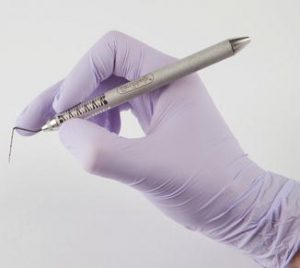
Pencil Grip
Periodontal Probe:
- Periodontal probes are used to determine gingival pocket depth as well as the size of any measurable abnormalities in the oral cavity.
- The notched periodontal probes have notches at 1, 2, 3, (skip 4), 5, (skip 6), 7, 8, 9, and 10.
- Banded probes have bands that each represent 3 mm in length.
- Held with a pencil grip
Calculus Removal Forceps / Tartar Removal Forceps / Extractors (DII)

- This instrument is used for quick manual removal of large pieces of calculus.
- There are two tips: 1) the longer tip is placed over the crown, and 2) the shorter curved tip is placed under the edge of the calculus. The calculus is sheared off the tooth when the two parts of the handle are brought together.
- Be careful not to damage the enamel surface or gingiva!
- Held with a palm grip
Scalers

- Scalers are used for scaling calculus from the crown surface; they are useful in removing calculus from narrow but deep fissures.
- They have a sharp point (or tip), two cutting edges, and a flat side between the cutting edges. The cutting edges are the working portions of the scaler.
- They are for supragingival or above the gingiva scaling only (using them for subgingival / below the gingiva scaling may damage the gingiva and periodontal ligament).
- Held with a pencil grip
Curettes
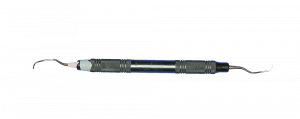
- Curettes are useful for calculus removal supragingivally and subgingivally; they are the only instrument to be used subgingivally.
- They have two sharp sides and a round toe.
- Universal curettes can be adapted to all dental surfaces, whereas area-specific curettes are adaptable to specific areas of the mouth.
- Used for Root Planing – the process of removing subgingival calculus and a layer of cementum to smooth the root surface in order to allow the gingiva to reattach and slow the progression of periodontal disease.
- Held via a pencil grip
Periosteal Elevators

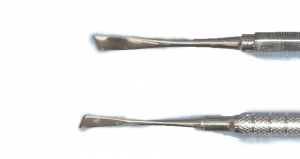

Periosteal Elevators- used to expose the alveolar bone when raising a mucoperiosteal flap during oral surgery.
- different patterns are available
- Spoon-like blade in line with a handle. Handle can have another spoon-like blade or a triangular blade.
- Edges of the spoon and triangle are sharp to help separate the periosteum from the alveolar bone.
- The smooth side is used against the back side of the gingiva and the sharp side is directed toward the bone.
- Held via an overhand grip with the index finger extended along the shaft in order to apply downward pressure
Needle Driver/Needleholder
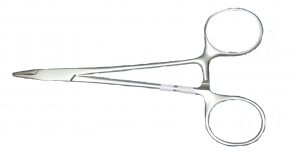
Needle Driver/Needleholder – used to hold a suturing needle to aid in closing any gingival incisions during oral surgery.
- Many types available including Olsen Hegar’s, Mayo’s, and Castro Viejo’s among others.
- Can have tungsten carbide inserts on the grasping plates of the tips.
- Typically, Mayo Needleholders are used in veterinary dentistry
Thumb Forceps
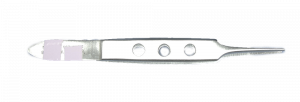
Thumb Forceps – used for grasping, holding firmly, or exerting traction during oral surgery.
- There are many types available with different styles of grasping ends including Brown Adson, Bishop-harmon, and Debakey.
- Attempt to minimize trauma to the gingiva when grasping with forceps.
- Held via a pencil grip
Blade/Scalpel Handle #3

Blade/Scalpel Handle #3 – used to stabilize scalpel when making incisions in veterinary medicine
- Short handle useful for making skin and gingival incisions, typically superficial tissue
- #15 blade is most commonly used in oral surgery
- Typically held in a pencil grip fashion to allow for fine and delicate gingival incisions in the mouth.
Scissors
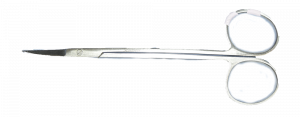
Scissors – used to cut soft tissue and suture material in veterinary medicine.
- Many styles and types of scissors with different cutting surfaces are used in veterinary medicine including Mayo, Iris, and Metzebaum.
- Iris scissors are used most frequently in oral surgery
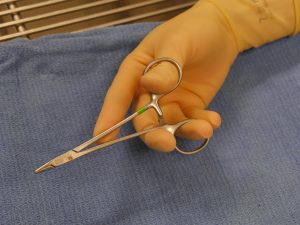
Grip for Scissors
Extraction Forceps
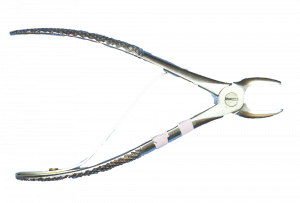
Extraction Forceps – used to grasp and luxate teeth, then remove teeth from the alveolus.
- Many styles of dental extraction forceps are available with the most common being the small breed extraction forceps.
- There are different styles of forceps for removal of different teeth in the mouth.
Luxators

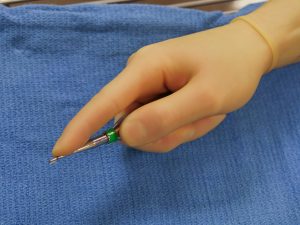
Luxators – used to cut gingival attachment and periodontal ligament.
- The working end is very thin and sharp and is inserted into the periodontal space where it severs the periodontal ligament.
- Luxators should not be used for leverage (twisting and turning) as the tip is too thin and weak to withstand this type of pressure.
- There are many sizes of luxators to provide an appropriate range for each size of root.
- Held via an overhand grip with the index finger extended down the shaft to act as a safety stop in order to prevent or minimize unintended trauma during extraction of teeth.
Elevators
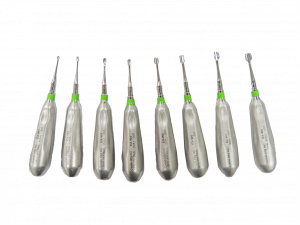
Elevators – used to breakdown the periodontal ligament.
- The working end is thicker than a luxator with a rounded or squared sharpened tip
- Elevators breakdown the periodontal ligament with a combination of apical pressure and leverage (twisting and turing along the axis).
- One type of modified end is a winged elevator and these are most commonly used in veterinary dentistry.
- Held via an overhand grip with the index finger extended down the shaft to act as a safety stop in order to prevent or minimize unintended trauma during extraction of teeth.
One point of interest – luxators are typically used to start an extraction, elevators are used to further the process and finally, extractors are used to remove the tooth.
Periodontal Pack
The periodontal pack includes those instruments needed to perform a routine dental cleaning and dental charting. The surgical pack contains the items necessary to perform oral surgery and dental extractions. However, in this lesson we will focus on the periodontal pack.
Periodontal Pack
The periodontal pack includes the following:
- Explorer with Periodontal Probe
- Calculus Removal Forceps
- Scaler
- Curette
Surgical Pack
Surgical pack includes:
- Blade Handle #3
- Periosteal elevators
- Extraction Forceps
- Thumb Forceps
- Needle Drivers
- Iris Scissors
- **size #15 blade and a pack of absorbable suture such as Monocryl® (polyglecaprone, Ethicon) are also needed for oral surgery, but not included in the surgical pack as these come in individual sterile packs(insert picture of Periodontal pack and Surgical pack with labels)
Wrapping Up
In this lesson, you learned about the instruments used in veterinary dentistry. Knowing the function and use of each of these instruments will help you to make better assessments regarding treatments for individual teeth. Understanding how to use each instrument will make dentistry more feasible and enjoyable.
In our next lesson, we will learn how to identify each tooth in dogs and cats.
Before Moving On …
Use the self-check activities below to practice identifying veterinary dental instruments.